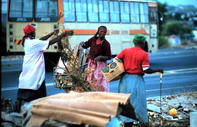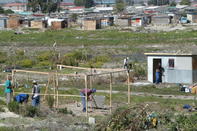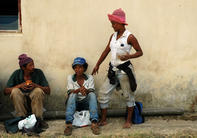The Poverty Trap

The one thing that characterises all famines - those which took place in the 1300s, and those which happen today in Africa - is that the poor carry the full weight of catastrophe. Whenever a seller's market dominates, consumer demand pushes up prices. When that market is food, it is always the poor who will go to bed hungry. Not those of us who are accustomed to foraging along bulging supermarket aisles.
Nor those of us who enjoy the indulgent middle-class luxury of self-exploration as we backpack around different areas of the globe. The adventure-seeking student's momentary discomfort or concern about the next meal can easily be rectified or escaped. That palpable insecurity bears no relation to the abject poverty and suffering of Africa's marginal people or the world's poor. Those in the poverty trap have no escape route.
Dr Scott Drimie, senior research specialist with the Integrated Rural and Regional Development Unit of the Human Sciences Research Council (HSRC), believes that the South Africans most vulnerable to food insecurity are those still living in former Bantustan areas. Here they are often cramped up into marginal land, endure grinding poverty and are situated far from government services. Their children - whose little bellies are often bloated with kwashiorkor - are the ones most likely to succumb if famine strikes.
For these people there is simply no margin for error. Helping the poor to help themselves, as many do-gooders will, is not as easy or simple as giving each household a bag of seed. Planting crops requires capital - land, the means to plough, water, and time - and the investment is not always guaranteed to bring returns. If the rains fail, a season's worth of work is lost and there are no savings to fall back upon.

Many people in these areas would prefer wage labour and it is this imperative that drives urbanisation. About 55 per cent of South Africans now live in cities, creating a whole new sector of potential food insecurity that Drimie believes is not fully understood. Informal housing, on the periphery of the country's urban centres, provides meagre shelter for millions of people who have moved to the city in search of work. Many don't find work.
Unemployed, they have no cash income to buy food. Newly urbanised, they also have no arable land to grow food. What will happen to these people living on the fringes of the economy if maize shortages of twenty per cent hit the country in the next few decades? If they don't have money to buy food and no means to grow their own, what do they do?
The Animal Will Eat Itself

Institutionalised religions and centuries-worth of accumulated ego have given humans the belief that we have dominion over the planet, that we are somehow removed from its processes and are superior to the workings of nature. It's time for a reality check.
The same rules governing population dynamics in any animal or plant species apply to us in equal measure. An ecological speed wobble will eventually develop, when a species begins to overrun its habitat, using up the resources and outcompeting other creatures, with which it must cohabit. So successful is Homo sapiens that it has exploited nearly every available niche across the planet, including some of the most inhospitable places on Earth.
Within the next fifty years, the global population is expected to reach eight to ten billion. Optimists say we will continue to keep the banquet table groaning under the weight of ample food, while our inherent good will keep spreading the abundance.
Pessimists say that soils are faltering, the struggle for water will bring out the war-monger in us, and there's only so much that our species can extract from this spinning piece of rock, with its miniscule shroud of life-supporting biosphere. When the fight for life comes, the animal will start to eat itself.